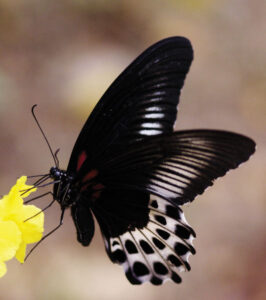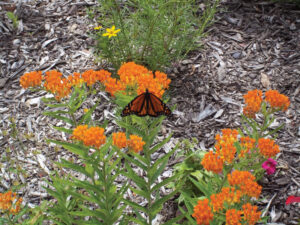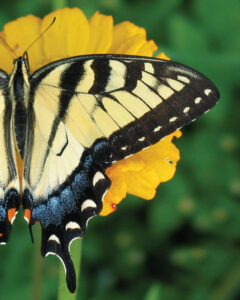
By: Barbara Sherwood
Imagine a world without crisp apples, strong coffee, autumn pumpkins, and sweet chocolate. If not for pollinating insects, such as butterflies and bees, this could be our reality! Did you know that pollinators help produce more than a third of the foods we eat? We depend on these hard working creatures, but their numbers are dwindling in the wild because we have replaced their natural habitat with our roads, cities, and neighborhoods. In the Midwest alone, the loss of prairies, forests, and wetlands have left many butterfly species vulnerable and in desperate need of our help. Recreating their natural habitat on large plots of land is not often feasible, however you can create smaller-scaled wild spaces for these valuable creatures within your own community. In fact, there’s something that every household can do to make a difference: plant a butterfly garden! By sharing small portions of our yards with pollinators, we create patches of habitat that support their populations and beautify our landscapes.
Planning your Garden
 Butterfly gardens can be any shape or size, but should mimic the diversity found in the pollinators’ natural environment. Gardens containing plants of various heights, colors, and bloom-times will attract the greatest variety of bees and butterflies. An ideal butterfly garden has blossoms in the spring, summer, and fall that offer nectar throughout the growing season. Grouping flowers in blocks of color makes it easy for pollinators to find your garden, and including a shallow, preferably muddy, water source gives butterflies the perfect place to drink.
Butterfly gardens can be any shape or size, but should mimic the diversity found in the pollinators’ natural environment. Gardens containing plants of various heights, colors, and bloom-times will attract the greatest variety of bees and butterflies. An ideal butterfly garden has blossoms in the spring, summer, and fall that offer nectar throughout the growing season. Grouping flowers in blocks of color makes it easy for pollinators to find your garden, and including a shallow, preferably muddy, water source gives butterflies the perfect place to drink.
It’s very important to choose plants that will provide butterflies with food throughout their life cycles. Adults need nectar, while caterpillars feed on plant foliage. What’s more, the caterpillars of many butterfly species can only eat specific “host” plants which are necessary for their survival. The stately monarch butterfly only lays its eggs on milkweed varieties, so swamp milkweed and butterfly weed are both great choices for your garden. Native grasses, such as little bluestem and switch grass, host a variety of prairie-dwelling skippers; herbs like dill and parsley serve as host plants for swallowtail butterflies. You can find a list of recommended nectar and larval host plants online through the University of Illinois Extension’s horticulture group (http://urbanext.illinois.edu/gardenerscorner/issue_02/spring_04_06.cfm).
 Whenever possible, choose native plants which have evolved alongside local pollinators and are best adapted to the soil and climate of our region. Most native plants are drought resistant perennials that are easy to maintain once established. Some great choices are aster, purple coneflower, black-eyed susan, Joe-Pye weed, geranium, phlox, and salvia. Native plants are not hard to find: as the demand for natural landscaping rises, nurseries specializing in native plants are sprouting up in the Midwest. Look for native plant suppliers and native plant sales events in your area!
Whenever possible, choose native plants which have evolved alongside local pollinators and are best adapted to the soil and climate of our region. Most native plants are drought resistant perennials that are easy to maintain once established. Some great choices are aster, purple coneflower, black-eyed susan, Joe-Pye weed, geranium, phlox, and salvia. Native plants are not hard to find: as the demand for natural landscaping rises, nurseries specializing in native plants are sprouting up in the Midwest. Look for native plant suppliers and native plant sales events in your area!
A Local Example
Last summer, while volunteering at Wheaton’s Cosley Zoo, I learned how quickly a new butterfly garden can become an important stop for pollinating insects. I had the opportunity to monitor the zoo’s recently installed butterfly garden. This garden has a trickling water fountain, several shrubs, small trees, native grasses, wildflowers, and numerous annuals that nourish and protect its tiny visitors.
 For four weeks, zoo guests helped me study the garden’s ability to attract wild pollinators by counting and recording butterflies and bees. The results we got were impressive for a garden only in its second year of blooming. We watched several species of colorful butterflies– cabbage whites, monarchs, tiger swallowtails, red-spotted purples, spring azures, red admirals, and various skippers– perching on flowers, resting in the shrubs, drinking from the fountain, and flitting around. A variety of bees, busy gathering pollen and drinking nectar, were regularly spotted throughout the garden. I discovered that the more time I spent in the garden the more wildlife I encountered. There were songbirds, hummingbirds, damselflies, and even dragonflies using the garden’s resources!
For four weeks, zoo guests helped me study the garden’s ability to attract wild pollinators by counting and recording butterflies and bees. The results we got were impressive for a garden only in its second year of blooming. We watched several species of colorful butterflies– cabbage whites, monarchs, tiger swallowtails, red-spotted purples, spring azures, red admirals, and various skippers– perching on flowers, resting in the shrubs, drinking from the fountain, and flitting around. A variety of bees, busy gathering pollen and drinking nectar, were regularly spotted throughout the garden. I discovered that the more time I spent in the garden the more wildlife I encountered. There were songbirds, hummingbirds, damselflies, and even dragonflies using the garden’s resources!
Can you imagine having that kind of biodiversity in your own yard? How about throughout your community? It’s time for us to make room in our neighborhoods for the pollinators we rely on so heavily. Let’s show our appreciation for their beauty and their work by planting butterfly gardens. Let’s bring the pollinators home!
About the author: Barbara is an Illinois resident and a graduate student with Project Dragonfly at Miami University in Oxford, Ohio. Her studies focus on greening communities through ecological restoration. She thanks Cosley Zoo staff for all of their support.









